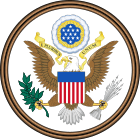Passport Act of 1920 facts for kids
 |
|
| Long title | An Act for expenses of regulating entry into the United States, in accordance with the provisions of the Act approved May 22, 1918, and Public Act Numbered 79 of the Sixty-sixth Congress, when the latter Act shall have become effective, $250,000, in addition to the remaining $150,000 of the sum appropriated by section 4 of said Public Act Numbered 79. |
|---|---|
| Nicknames | Passport Control Act, 1920 |
| Enacted by | the 66th United States Congress |
| Effective | July 1, 1920 |
| Citations | |
| Public law | Pub.L. 66-238 |
| Statutes at Large | 41 Stat. 739 aka 41 Stat. 750 |
| Codification | |
| Titles amended | 22 U.S.C.: Foreign Relations and Intercourse |
| U.S.C. sections created | 22 U.S.C. ch. 4 §§ 214, 215, 216, 217 |
| Legislative history | |
|
|
| Major amendments | |
|
|
The Passport Act of 1920, also known as the Passport Control Act, 1920, was an important law passed by the United States Congress. This law helped manage how people entered and left the United States. It also set rules for passports and visas, which are official documents needed for international travel.
This act was signed into law by President Woodrow Wilson on June 4, 1920. It changed some older rules about who could get a U.S. passport.
Contents
What Was the Passport Act of 1920?
The Passport Act of 1920 was a federal law created by the 66th United States Congress. It was a type of law called an "appropriations bill," which means it set aside money for certain government activities. In this case, it provided funds for the United States Foreign Service, which helps Americans abroad.
Why Was This Law Created?
This law was passed after World War I. During the war, the U.S. had a special law called the Wartime Measure Act of 1918. This act gave the government more power to control who could travel in and out of the country. It also made U.S. passports mandatory for travel.
Even after the war ended, the government wanted to keep some control over travel. So, Congress created the Passport Act of 1920 to replace and update the wartime rules. It officially took effect on July 1, 1920.
Key Changes from the Act
The Passport Act of 1920 made several important changes to how passports and visas were handled:
- Setting Fees: The law set new fees for applying for and getting passports and visas. This meant travelers had to pay a specific amount for these documents.
- Passport Validity: It limited how long a passport or visa could be valid. Generally, they were good for two years. However, the U.S. Secretary of State could decide to make them valid for an even shorter time if needed.
- Rules for Non-Citizens: The act changed a part of an older law, the Expatriation Act of 1907. Before 1920, some people who didn't declare themselves U.S. citizens could still get passports. The new act stopped this, making it clear that passports were for U.S. citizens.
- Refunds for Refused Visas: If a foreign country refused to give someone a visa, the act said that the fee paid for the passport could be returned.
President Woodrow Wilson's Role
President Woodrow Wilson signed the Passport Act of 1920 into law. This was an important step in shaping how the United States managed international travel and citizenship in the years after World War I.

